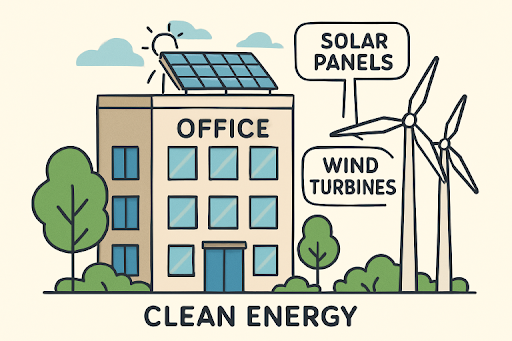As businesses face mounting pressure to innovate and adapt in an increasingly eco-conscious world, adopting clean energy solutions is emerging as a core strategy for resilience and growth. Today’s business leaders are looking beyond traditional power sources and investing in solutions that not only reduce environmental impact but also power profitability and expansion. In this dynamic landscape, forward-thinking companies are embracing clean energy as a key enabler of operational excellence—and a critical lever for meeting evolving stakeholder expectations. One such solution, Bloom Energy Power Engineering, exemplifies how advanced technologies are driving this transformation.
Adopting clean energy is no longer a niche pursuit; it’s a necessity to ensure regulatory compliance, cost competitiveness, and robust risk management. With global supply chains and investor scrutiny intensifying, clean energy investments have become a stake in the ground for long-term viability. Customers and partners alike are increasingly aligning with brands that demonstrate authentic commitments to sustainability, with clean energy at the center of their business strategies and stakeholder engagement worldwide.
Economic Benefits of Clean Energy Adoption
Clean energy investments offer compelling economic advantages, from stabilizing operating costs to unlocking new revenue streams. In 2024 alone, global spending on renewable and clean technology soared to a record $2.1 trillion, fueling innovation across sectors such as smart grids, transportation, and distributed power generation. The green energy sector is now driving most of the new power plant developments in the U.S., accounting for more than 90% of new construction. This shift is helping businesses decrease their long-term energy expenses, reduce exposure to market volatility, and access emerging opportunities in clean tech-driven markets.
Financial incentives from governments, energy price hedging, and enhanced operational efficiency are additional monetary benefits. According to Forbes, business and clean energy investments are increasingly recognized as key drivers of economic momentum, reinforcing the idea that sustainability is not just environmentally sound but also financially strategic. Companies that prioritize clean energy are also better positioned to attract investment, as sustainability credentials are increasingly factored into lending decisions and partnership evaluations by both private and institutional investors.
Enhancing Brand Reputation and Consumer Trust
Public awareness around environmental issues has reached unprecedented levels, and consumer preferences are following suit. According to a recent survey, nearly three-quarters of global consumers report that they would change their purchasing habits to reduce environmental impact. Brands harnessing clean energy can project genuine environmental stewardship, earning loyalty among eco-conscious buyers and bolstering their overall reputation.
This competitive differentiation not only drives retention but is also an increasingly relevant factor in talent acquisition and retention. Employees, particularly millennials and Gen Z, consistently rate environmental responsibility as a critical criterion in their employment decisions. As such, clean energy initiatives foster a sense of pride and purpose within the workforce, deepening organizational alignment with strategic values.
Regulatory Compliance and Risk Mitigation
Governments worldwide are tightening emissions and sustainability standards, holding companies accountable for their ecological footprints. Transitioning to clean energy helps organizations to proactively meet and exceed these requirements, thereby reducing the risk of fines, litigation, and brand damage. Beyond compliance, the move to clean energy insulates businesses from fossil fuel price swings, supply chain uncertainties, and emerging carbon taxes or tariffs.
Managing these risks is no longer a background concern but a strategic imperative, especially for companies with global supply chains or those operating in regions with aggressive environmental policies. Clean energy adoption sends a strong signal to regulators and investors that a business is responsive to current and future risk factors, while also sharpening its readiness for high-stakes market changes.
Technological Advancements Facilitating Transition
Continuous innovation is making clean energy more accessible, affordable, and tailored to different business models. Solar photovoltaics (PV), for example, are now nearly 90% cheaper than a decade ago, transforming the economic calculus for rooftop and off-site solar power. Enhanced battery storage solutions and advancements in power management software make it feasible for companies of any size to operate on a greater share of renewables. AI-powered analytics and smart grid technologies have further enhanced efficiencies in monitoring, load balancing, and predictive maintenance, thereby reducing costs and enhancing resilience.
Case Studies of Successful Implementation
Business leaders across various industries are setting ambitious clean energy targets and rapidly moving toward implementation. Walmart, the world’s largest retailer, has pledged to run entirely on renewable energy by 2035, installing thousands of solar arrays across its global footprint and investing in both wind and local generation solutions. Similarly, Google has matched its energy use with renewable energy purchases since 2017, exemplifying how scale and innovation converge in successful transitions.
These examples demonstrate that strong leadership, clear goal-setting, and a commitment to long-term return on investment are essential for navigating challenges and achieving measurable results in clean energy adoption.
Challenges and Strategies for Overcoming Them
Despite the clear benefits, decision-makers may encounter hurdles—ranging from substantial upfront costs to integrating new systems with legacy operations. Solving these challenges often requires a multi-pronged approach:
- Utilizing government grants, rebates, and tax credits to defray physical and financial barriers.
- Contracting with innovative energy providers to co-develop tailored power purchase agreements (PPAs) and solutions.
- Ramping up staff education and recruiting specialized talent for seamless technology integration.
Strategic partnerships and a phased transition plan enable businesses to strike a balance between innovation and risk management, making clean energy transformation feasible even for organizations with complex infrastructure or distributed operations.
Future Outlook and Emerging Trends
The coming decade will witness the maturation of smart grids, decentralized energy production, and the mainstream adoption of artificial intelligence in energy optimization. Peer-to-peer energy trading and microgrid development are on the rise, further strengthening businesses’ capacity to achieve energy independence and resilience. As sustainability disclosure standards evolve and consumer activism intensifies, those who embrace these trends will retain a clear edge, positioning themselves as responsible and future-ready market leaders.
Conclusion
Clean energy is rapidly transitioning from an elective upgrade to a strategic imperative across the business landscape. The convergence of economic gains, reputational value, compliance readiness, and cutting-edge technology solidifies its role as a foundational pillar for modern enterprises. By seizing the momentum now, businesses elevate not only their operational and market performance but also their contributions to a healthier, more sustainable world.

